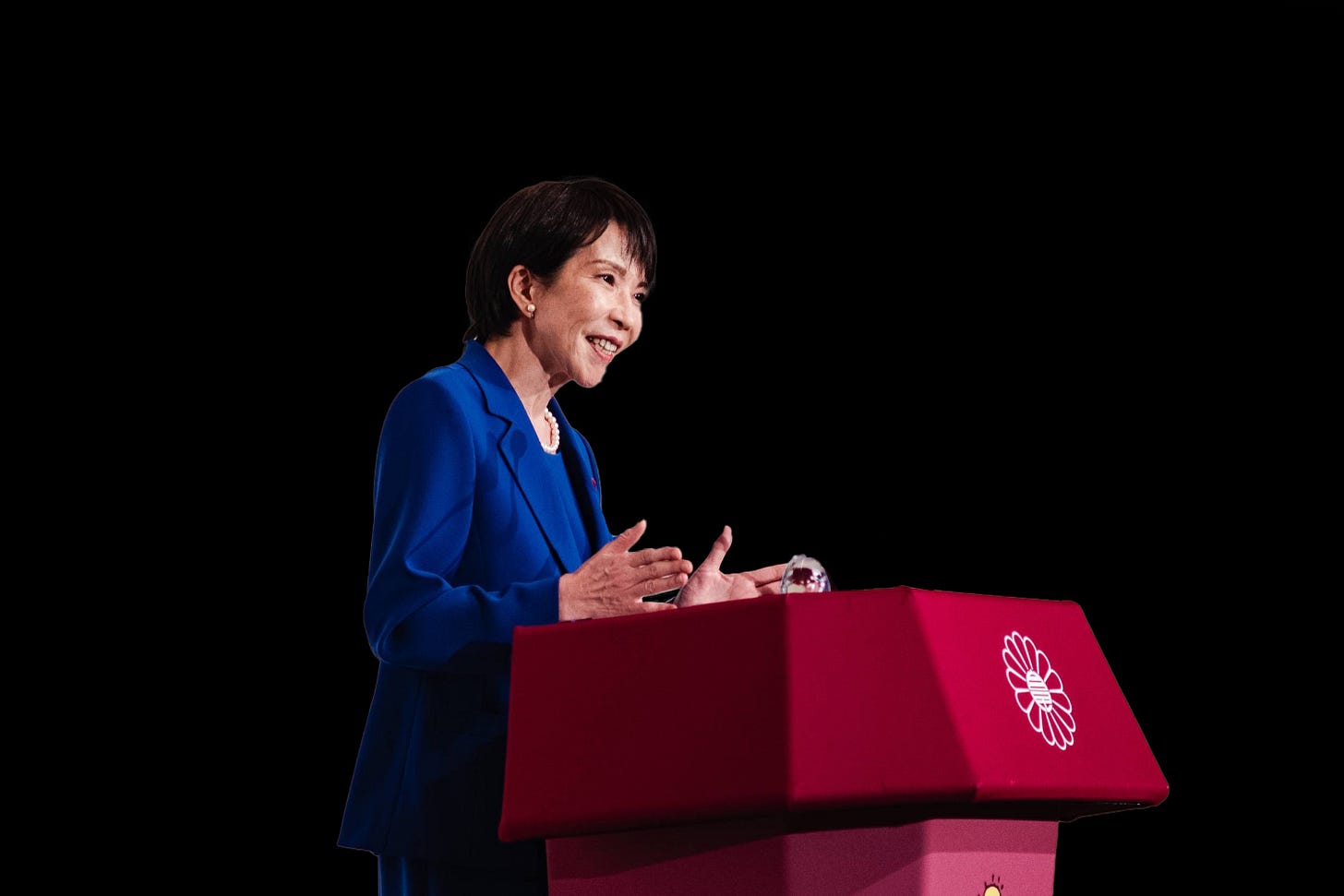The Takaichi Trade
Comparisons to Truss, Thatcher, and a reborn Abenomics... Welcome, Takaichinomics.
Monetary dovishness, fiscal expansion, tax relief, and pro-business rhetoric have defined the policy mood of 2025, a year when running it “hot” has become political consensus in Washington.
This week, the same melody is playing again, but not from the Treasury or the White House. It’s coming from Tokyo, where Sanae Takaichi, the frontrunner to become Japan’s next prime minister, is tuning Japan’s policy orchestra to a familiar score. Markets caught the rhythm. The Nikkei surged nearly 5%, the yen tumbled past ¥150, and long-dated JGB yields steepened sharply as markets rushed into what is now dubbed the Takaichi Trade.
Japan’s policy pivot is now priced as both a reflation story and a fiscal one. The market’s initial conviction is high, but follow-through is another matter.
With Takaichi poised to lead, we expect Japan’s post-Kishida caution to give way to something bolder: a revival of Abenomics with fewer apologies. “Run it hot” has gone global. Fiscal populism is back in vogue.
This isn’t Japan’s first act of market drama this year. Back in May, we wrote “The Return of Bond Vigilantism”, stating that Japan’s long end was fragmenting under the weight of its own fiscal gravity, a “buyer’s strike” masquerading as a taper tantrum. In our July note “Political Drift Has Consequences”, we warned that the LDP’s electoral slide would force fiscal accommodation onto a reluctant Ishiba government, steepening the curve and eroding the illusion of discipline.
Now, the market has connected those dots for us. The Takaichi Trade is simply the logical crescendo: fiscal reacceleration made explicit, with a monetary authority too cautious to resist.
Abenomics 2.0, But Louder
Japan’s fiscal hand is back on the wheel. The setup mirrors Washington’s: easy money and deficit largesse. But Japan has seen this movie before. It was famously called Abenomics.
Takaichi, a loyal Shinzo Abe disciple, has never hidden her admiration for the late prime minister. Her campaign slogan, Japan Is Back, was lifted straight from his 2012 manifesto. The intellectual scaffolding is similar as well, a mix of fiscal expansion, monetary accommodation, and structural reform (though in practice, the first two always carried the melody).
But this isn’t 2012. Abe was fighting deflation then. Takaichi inherits inflation fatigue, a fractured party, and a bond market that’s already uneasy about fiscal drift. What was once a stimulus to revive demand is now a stimulus to manage discontent. The distinction matters.
Markets have already started to price that difference, not one of optimism, but one of velocity. The yen’s sharp weakening and the steepening in the JGB curve suggest investors view Takaichinomics less as reform and more as reflationary pressure. Still, it’s hard not to see the Thatcher shadow looming over her rise. Takaichi has openly styled herself as Japan’s Margaret Thatcher: a conviction politician with nationalist instincts and a disdain for bureaucratic inertia. Yet the economic moment she faces looks far closer to Liz Truss’s than Thatcher’s.
Abe had the tailwinds of a supportive BoJ, a unified LDP, and an electorate that feared stagnation more than inflation. Takaichi inherits the opposite: a divided parliament, an exhausted policy framework, and markets that are quicker to punish missteps.
The comparison to Truss isn’t just lazy shorthand. Like Truss, Takaichi’s instincts lean expansionary: lower taxes, looser money, more spending. But she’s also savvy enough to surround herself with fiscal veterans, Aso and Suzuki, to keep the bond market calm. Japan’s institutions, unlike those in Britain, still prize continuity over confrontation. The presence of Aso at her side is both symbolic and insurance.
@bauhiniacapital, a voice we respect regarding Japanese economics, had this to say:
“Aso’s job is to keep the rest of the LDP in line. He is effectively the kingmaker here (and was in the runoff election). He disliked Ishiba. Intensely. He was the first to call for Ishiba’s ouster post-Upper House election.
I’d note that during the summer, the populace actually had a decent view of Ishiba, despite his mini-scandal. The LDP factions were much less supportive. Takaichi may have been chosen just to try to win back some support from Sanseito, which has grown in strength as strongly social conservative RW LDP voters defected post-Abe.
Some of the opposition parties are ready to unite against the LDP, but I don’t think that coalition would last long either. I think Takaichi is a stopgap. She has some LDP member (public, not lawmaker) support, but not a lot of popular support outside the LDP membership (which is less than 1 million people). I think her government hobbles along for a while. The hope is that if she can put some wins on the board, then call an election (which is what Abe did), the LDP could again win a Lower House majority, and then the real work could begin. I remain unconvinced that it will be successful long-term. Everyone likes free money, but there are a lot of Japanese people who don’t like her brand of social conservatism.”
Politics will take time to play out. Markets, as usual, have moved first.



